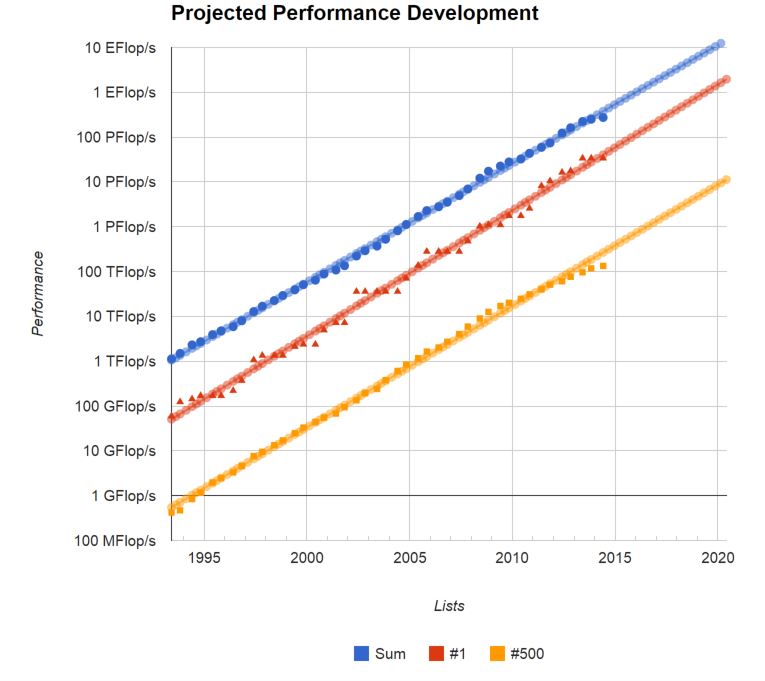Exeter to host Europe’s biggest supercomputer
The Meteorological Office in Exeter is to spend £97m on a new supercomputer system that will be the biggest in Europe when it is up and running. This will also open up opportunities for open data operations alongside the Met Office campus.
The system will be based around the newly announced Cray XC40 and other next generation Cray XC systems with next generation Intel Xeon processors providing performance of 16,000 teraflops (16PFlops) from 480,000 cores. This will provide 13 times the performance of the current IBM supercomputer but puts it in the middle of the global performance range by the time it is full operational in 2017 (see chart from the top 500 supercomputers). This is Cray’s largest contract outside the US and follows the establishment of Cray’s R&D Centre in Bristol.
“This will make a real meaningful difference to the SW,” said Dave Underwood, Deputy Director of High Perf Computing at the Met Office, speaking to SW Innovation News. “We will have 17Petabytes of storage – this is high tech and we are doing it in the SouthWest.”
He sees the opportunity for companies to cluster around the supercomputer on the Exeter Science Park to take the data outputs from over 10 million weather observations a day that create an atmospheric model for 3,000 tailored forecasts and briefings each day. It is also one of only two centres in the world that provide forecasts of weather above 25,000 ft. Companies will have to be co-located due to the bandwidth requirements.
Storage bandwidth is also vitally important, and the next-generation Cray Sonexion storage solution will be delivered in phases and will include more than 20 petabytes of storage capacity, running at speeds of more than 1.5 terabytes per-second of bandwidth. Cray’s Sonexion storage system combines Cray’s Lustre expertise tightly integrated in a unique design that allows for maximum scalability. Management and operations are simplified through an appliance design with all storage components including software, storage and infrastructure.
Today’s supercomputer uses 5.5MW of energy, which will rise to 12MW when the new system is fully up and running in 2017 as it runs at 99.9% utilisation, says Underwood.
“We are very excited about this investment in UK science,” said Met Office Chief Executive Rob Varley. “It will lead to a step change in weather forecasting and climate prediction, and give us the capability to strengthen our collaborations with partners in the South West, UK and around the world. The new Cray supercomputers, together with improved observations, science and modeling, will deliver better forecasts and advice to support UK business, the public and government. It will help make the UK more resilient to high impact weather and other environmental risks.”

Projected performance of supercomputers over the next five years – the fastest machines are predicted to top 100PFLOPS by 2017.
“The award is symbolic for Cray on a number of fronts — it demonstrates that our systems continue to be the supercomputers of choice for production weather centers across the globe, that our close relationship with Intel is providing customers with enhanced capabilities today and into the future and it reinforces the role that Cray plays in impacting society on a daily basis in a wide range of areas,” said Peter Ungaro, president and CEO of Cray. “The Met Office is both a pioneer and leader in weather and climate services, and we are excited that Cray supercomputers and storage solutions will assist them in achieving their important and complex mission of informing citizens and industry how the weather and climate will affect them now and in the future.”
The XC40 supercomputers include Cray’s Aries system interconnect; a network topology called Dragonfly that frees applications from locality constraints; DataWarp applications I/O accelerator technology; innovative cooling systems to lower customers’ total cost of ownership; the next-generation of the scalable, high performance Cray Linux Environment supporting a wide range of applications; Cray’s HPC optimized programming environment for improved performance and programmability, and the ability to handle a wide variety of processor types in a tightly-integrated system infrastructure.
The most powerful supercomputer in Europe at the moment is at the Swiss National Supercomputing Centre (CSCS) and is based on Cray’s XC30 system providing 7.8PFlops.
Related articles
Comments
Tell me what you're thinking...
and oh, if you want a pic to show with your comment, go get a gravatar!





